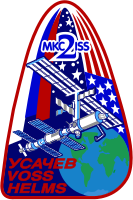Ekspedycja 2
 | |
| Dane misji | |
| Oznaczenie kodowe | Expedition 2 |
|---|---|
| Pojazd | |
| Pojazd dowożący | |
| Pojazd powrotny | Discovery STS-105 |
| Załoga | |
 Od lewej: James Voss, Jurij Usaczow i Susan Helms | |
| Dowódca | |
| Załoga | 3 |
| Start | |
| Miejsce startu | |
| Początek misji | 8 marca 2001, 11:42:09 UTC |
| Wyjście w przestrzeń kosmiczną | 1.EVA - 19 min |
| Orbita okołoziemska | |
| Liczba orbit | 2635[1] |
| Apogeum | 396 km |
| Perygeum | 384 km |
| Okres orbitalny | 92 min |
| Inklinacja orbity | 51,6°° |
| Misja ISS | |
| Pobyt na stacji ISS | 163 dni 08:13:30 |
| Lądowanie | |
| Miejsce lądowania | |
| Lądowanie | 22 sierpnia 2001, 18:24:06 UTC[2] |
| Czas trwania misji | 167 dni 06:41:57 |
| Przebyta odległość | ~111 152 720 km |
| Międzynarodowa Stacja Kosmiczna | |
Ekspedycja 2 była drugą stałą załogą Międzynarodowej Stacji Kosmicznej.
Załoga
- Jurij Usaczow (4), Dowódca misji i dowódca Sojuza (Rosja)
- James Voss (5), Inżynier lotu 1 (Stany Zjednoczone)
- Susan Helms (5), Inżynier lotu 2 (Stany Zjednoczone)
(liczba w nawiasie oznacza liczbę lotów odbytych przez każdego z astronautów)
Załoga rezerwowa
- Jurij Onufrijenko (2), Dowódca misji i dowódca Sojuza (Rosja)
- Carl Walz (4), Inżynier lotu 1 (Stany Zjednoczone)
- Daniel Bursch (4), Inżynier lotu 2 (Stany Zjednoczone)
Parametry misji
- Perygeum: 384 km
- Apogeum: 396 km
- Inklinacja: 51,6°
- Okres orbitalny: 92 min
Dokowanie do ISS
- Połączenie z ISS: 10 marca 2001, 06:38 UTC
- Odłączenie od ISS: 20 sierpnia 2001, 14:51:30 UTC
- Łączny czas dokowania: 163 dni, 8 godz., 13 min, 30 s
Zobacz też
Przypisy
- ↑ ISS: Expedition 2 (ang.). Space Facts, 2013-11-24. [dostęp 2014-06-30].
- ↑ STS-105 na stronie KSC (ang.)
Linki zewnętrzne
- ISS Expedition Two Crew. spaceflight.nasa.gov. [zarchiwizowane z tego adresu (2008-04-22)]. (ang.)
- ISS: Expedition 2 (ang.). Space Facts, 2013-11-24. [dostęp 2014-06-30].
Media użyte na tej stronie
Left to right :
De gauche à droite : James S. Voss, Yury V. Usachev, Susan J. Helms. Crew for the Expedition 2 to the ISS. (February 2001, NASA)
Cosmonaut Yury V. Usachev (center), Expedition Two mission commander, is flanked by the other crew members--astronauts James S. Voss and Susan J. Helms--who will join him for an extended stay aboard the International Space Station (ISS), beginning in March of this year. Usachev represents the Russian Aviation and Space Agency. The flags representing all the international partners are arrayed at bottom.ISS Expedition 2 insignia.
The International Space Station Expedition Two patch depicts the Space Station as it appears during the time the second crew will be on board. The Station flying over the Earth represents the overall reason for having a space station: to benefit the world through scientific research and international cooperation in space. The number 2 is for the second expedition and is enclosed in the Cyrillic MKS and Latin ISS which are the respective Russian and English abbreviations for the International Space Station. The United States and Russian flags show the nationalities of the crew indicating the joint nature of the program. When asked about the stars in the background, a crew spokesman said they "...represent the thousands of space workers throughout the ISS partnership who have contributed to the successful construction of our International Space Station."



